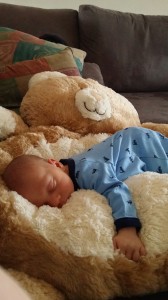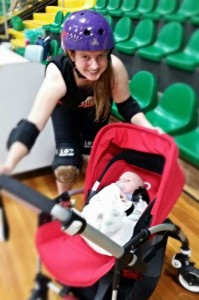First off, this isn’t a blog about what to do after producing offspring or strict recommendations for returning to derby, it’s just my story. The main reason for not writing a “how to” is that if there is one thing I have learnt it’s that there is no “right way” to do things when it comes to a new baby. Every tiny human is different in their needs and mum’s recovery may be totally different to mine.
Axel was born on Boxing Day at around 1 in the afternoon. He was 3145g and 51cm long. Delivered via Mighty Vac (yep that’s exactly what it sounds like) and I was given a recovery time around 4-6 weeks. In that first week after spawn, I started to assess myself for getting back to my derby fitness. Everything had gone squishy, my tummy felt like jelly and I was struggling to open jars and stuff, so I was thinking I had a fair bit of work ahead of me. There was also the other thing, stitches, ick. That had a healing time of up to 4-weeks. So I’d determined not to think about my fitness again until Axel was 4-weeks old.
That was probably for the best, any fluid from around my tummy was disappearing and my core wasn’t nearly as bad as I thought it would be. With some more settled sleeping patterns I was feeling stronger too. Whenever possible I got Axel in the stroller and went for a walk around the block and this seemed to do both of us plenty of good. TIP #1 BE PAITENT, LET YOUR BODY RECOVER IN ITS OWN TIME.
In that first month I started to really question my ability to go back to derby. Axel seemed to need to feed constantly. I felt like I was trapped on the couch with no hope of getting up for sandwich let alone a few hours of training time. If Axel wasn’t feeding, he was screaming and I definitely felt like a bit of a failure at this mum thing. But things seemed to level out a bit and we were slowly getting into a routine. TIP #2 PERSERVERE, A ROUTINE WILL COME.
 Awwwww, tiny baby sleeping Axel.
Awwwww, tiny baby sleeping Axel.
My first big derby test was attending a committee meeting in week 3. I tried expressing for a bottle feed for the first time. Oh my glob! FREEDOM!!! Not only could I keep Axel happily fed in the middle of a meeting I could actually hand over the reins to someone else (Dobie you’re my hero). TIP #3 BOTTLES ARE FANTASTIC, LET SOMEONE ELSE FEED BUBS AND ENJOY SOME GROWN UP TIME.
I got a chance to head to a team social at the beginning of week 4. I turned up looking totally frazzled and I kind of desperately asked my fellow mummy teammates for advice. I must have sounded so pathetic “Is this normal?” “Why won’t he do …?” “How long did your babies feed for?” I got a fair few knowing smiles and also plenty of hints and tips. Things didn’t seem so terrible after all. Soon after I’d figured out my offspring had dairy and egg protein sensitivity and it was causing him plenty of gas pains and I also got him soothing himself with a dummy. Hallelujah. TIP #4 MUM WISDOM IS PRICELESS. SERISOUSLY, JUST HEAR EVERYONE OUT AND SEE IF IT HELPS.
In our 5th week together I thought it was time to start thinking about strapping on skates. I’d been cautioned by fellow derby mumma Leese Lightning to take it easy when returning to training. She warned me about the relaxin hormone that takes months to leave your body after pregnancy. Sure it allows your body to give birth, but it also increases your risk of sprains and injuries so that is something to think about, lest you end your derby career before you even get back to it. TIP #5 RELAXIN, IT’S A THING. GOOGLE IT BEFORE HEADING BACK TO DERBY.
First I thought I would check out my core strength. I started off doing sit-ups, push-ups, planks and squats in small reps at first and then slowly building up. I found I could do the minimum skill level before too long, but it certainly wasn’t as easy as it used to be. Seeing as I could get to minimum endurance, I wanted to go to the next step. Skating. I decided to start back with our fresh meat
group. There was no pressure from my trainers to do this, I just wanted to because I didn’t feel stable or strong enough to jump into full contact training. Yet.
My first training session back on skates I left Axel with my mummsy and I attempted to complete 1 hour of training. We completed the 5-minute laps, admittedly I took it a bit easy but I only completed 21 laps. I was crushed, I’m no speedster but I hadn’t been that slow since fresh meat. TIP #6 SEE TIP #5. NO SERIOUSLY RELAXIN IS A THING! IT WILL MAKE YOUR LEGS FEEL LIKE JELLY WHILE YOU’RE SKATING. TAKE YOUR TIME AND BE CAREFUL!
For my next training sesh I brought the little guy with me. There were plenty of people just dying for a cuddle from Axel. I’d barely rolled him in the door before he was swaddled, fed, burped and tucked up into his pram for a sleep (Love you Bella). At first I was like “Oh you don’t have to…” but then I saw people really, sincerely, genuinely wanted to help. TIP #7 IT TAKES A VILLAGE OR A ROLLER DERBY LEAGUE TO RAISE A CHILD (JUST GO WITH IT).
So that’s pretty much our first 6-weeks. My next blog will be covering up to 12-weeks. I hear 12-weeks is a magical time where babies settle down a bit and learn heaps of new stuff. I wonder if that means he can start changing his own nappies and stuff. That would be most excellent. Until next time, have a good one.
Pixie.



